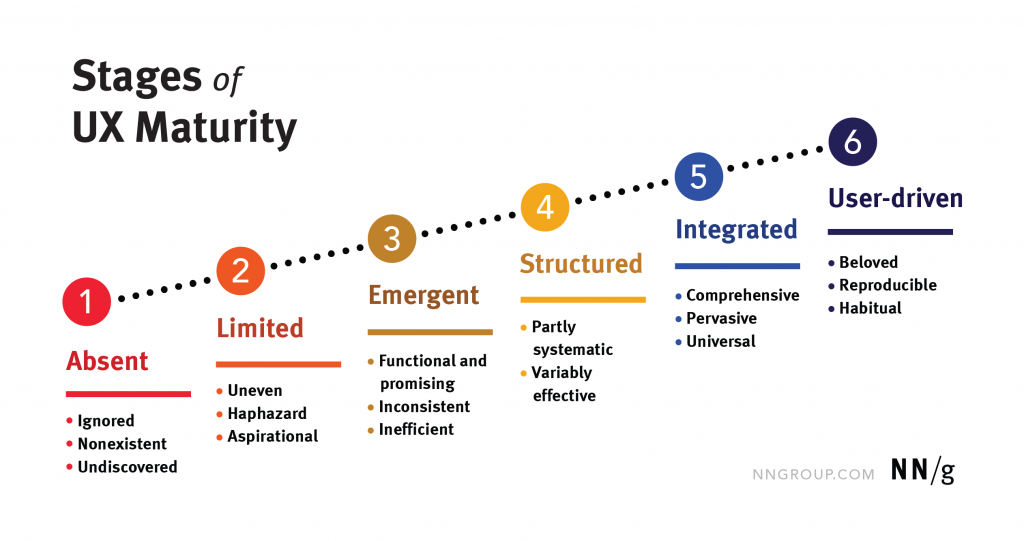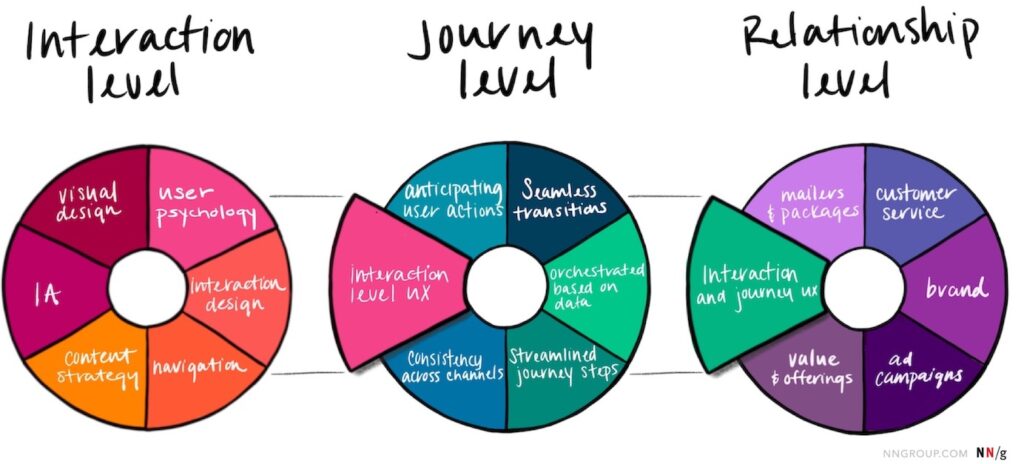When you think of user experience (UX), you probably think of digital apps, technology companies, and sticky notes. Although not incorrect, this discipline is more than just that. At its core, UX is about problem-solving – an obsession with meeting the needs and requirements of users. This is made possible by the disciplinary practice of human-centered design (HCD) and is a critical component of web design. As alluded to earlier, this places the needs of the individual at the center of devising solutions.
Human-centered design has successfully transformed problems into opportunities and developed real solutions for users that UX has been spread beyond the software and technology fields to include nonprofits, as in this design thinking workshop I conducted. However, the adoption of UX is not a singular event; it is a process. In any company and organization, it must be consistently cultivated and supported so it can achieve maturity. Here is why UX maturity matters.
UX Maturity Level
Rome wasn’t built in a day, and the same applies to levels of UX maturity within an organization. But first, what exactly does the term mean?
It refers to the resources, tools, support, research & design processes, operational practices within a given company. It also means consistent support of UX practices through leadership, organizational culture, and workforce.
According to Nielson Norman Group (NN/G), the stages of maturity are as follows:
- Stage 1: Absent
- UX is nonexistent in the absent stage, and user-centered thinking does not play a role in organizational or strategic decision-making. There may be a few advocates, but they cannot make an impact. The value of UX is not established.
- This stage focuses on building awareness of UX practices and slowly persuading critical stakeholders of the potential usefulness of user-centered thinking in the organization.
- Stage 2: Limited
- In the limited stage, there is little awareness and application of UX approaches in the organization. Generally, UX work is not done consistently in this stage, nor is it incorporated in strategy and planning. There is a growing awareness of the value and usefulness of UX.
- The focus in this stage is on the process. It is building UX infrastructure such as establishing regular routines and procedures and creating a team.
- Stage 3: Emergent
- In the emergent stage, UX is practiced in a semi-institutionalized way. There are dedicated resources and teams. However, the scale of initiatives is still relatively small and primarily due to the initiative of enterprising managers rather than organizational policy. The value of UX has been established but of limited utility.
- This stage focuses on building out the UX infrastructure with a significant focus on cultivating an organizational culture that supports User-design thinking at all levels.
- Stage 4: Structured
- UX has been thoroughly institutionalized in the structured stage because the organization understands the value that UX brings. Hence, now there are regular dedicated teams who practice human-centered design with dedicated support and budgets.
- The focus in this stage is on strategy or rather the potential lack of it. Issues that could arise in this stage have to do with the lack of clearly defined goals and metrics or development processes that do not include iterative design.
- Stage 5: Integrated
- In the integrated stage, UX has become comprehensive. Teams that practice HCD do it effectively and efficiently. In this stage, the organization should strive for, as UX has become highly instrumental in achieving business goals.
- The focus in this stage should be on user-centered outcome metrics.
- Stage 6: User-Driven
- In the user-driven stage, everyone is onboard with HCD. UX firmly drives and supports organizational strategy and project prioritization.
- The focus at this stage should be on maintaining this standard and not backsliding.

Why does this matter for purpose-driven organizations?
Bringing user experience and design thinking into the nonprofit world is a fruitful endeavor for every social enterprise and community-based nonprofit organization alike. The relentless focus on users (the people you serve), and obsession with formulating user-driven solutions would assist in being able to increase the impact of your programming and improve access to pertinent, potentially life-saving services. The human-centered design process can benefit communities and organizations, alike, and ultimately it is about meeting people where they are.
You may want to see our nonprofit web design case studies here.
Here’s a scenario: your organization has the objective of increasing the vaccination rate of people within a certain zip code, and you know community members have a problem accessing CVS, Walgreens, or Walmart because many don’t have a vehicle. Now, you can start to ideate on opportunities to solve this problem by facilitating a design thinking workshop with the community and by conducting outreach. You can gather a group of community leaders and members together, and ask them: How might we increase vaccination in our community? Chances are, many people don’t know where to go, and what information to trust, and you can discern that problem, together, and reframe it as an opportunity through a participatory human-centered design exercise called How Might We.
This means identifying and reaching strategic objectives and goals and even redefining them for the better. For example, human-centered design practices could help a nonprofit discover previously unknown user goals, motivations, and pain points. It also promotes collaborative thinking and co-creation, which assists in the fostering of innovation. This could help refine and enhance the mission work of the organization when it comes to serving its end-users towards better outcomes.
Should human-centered design practices like UX research & design (UXR/UXD) be widely adopted and cultivated over time as the UX maturity level demonstrates, it would successfully support managing and optimizing key user journeys, later leading to the larger customer experience transformation that would catapult impact to new levels. It would help organizations and nonprofits by propelling ecosystem co-creation initiatives based on its users’ actual (and not perceived) needs. Therefore, organizations and nonprofits interested in meeting the needs of their users should implement human-centered design practices immediately in their workplaces and processes, which requires a whole lot of collective learning and buy-in. And this all needs to be done before moving to be able to progress towards true customer experience transformation, which may often take years because it also requires a cultural shift and a substantial budget.
Related: Purpose-driven marketing
Going beyond user experience: most organizations will fail or struggle to actualize transformation
Digital transformation and customer experience (CX) transformation are cut from the same cloth. They both involve culture change, cross-functional collaboration, upskilling, and often take years. For some organizations, it is more challenging, and having a sense of UX Maturity is the first step logical step towards successful transformation.
The user experience can be broken down into three levels: Interaction, Journey, and Relationship.
- Interaction level (UX)
- Example: checking your bank’s balance using the app and quitting right after, which involves a single touchpoint
- Journey-level (UX)
- Example: taking out a mortgage or refinancing, which is a lengthy process and involves multiple touchpoints
Building on these two, customer experience levels in the CX transformation framework then takes it to the desired level:
- Relationship level (CX)
- Example: building a relationship with an individual over years, helping them bank and get their first mortgage and setup their business bank account and getting to know them. Keeping feedback loops open and providing mutually-beneficial wealth management services when the customer expresses pain in allocating their capital so it works for them.

Each level plays a crucial role in the overall customer experience and has its own unique constraints and goals. While Interaction level UX shapes the journey-level UX, and both influence the relationship level, it’s important to note that one level is not more important than the other. Organizations must strive to deliver a positive experience at every level. This will ensure a cohesive, satisfying, and effortless customer experience.
Customer Experience Transformation
The maturity of an organization’s user experience practices directly impacts CX maturity but doesn’t translate 1:1 for every organization and industry. Like a fingerprint, every organization, and individual is different. So, the transformation will look different to each organization, but there are some best practices in this customer experience transformation framework.
First, what exactly is customer experience transformation? According to NN/Group, it is the “transformation of an organization’s values, structures, operations, technology, and culture to mature its CX capabilities by creating an environment able to operate with a focus on the customer and deliver high-quality CX at scale.” And it’s important because CX transformation breaks down silos, enables the development of a system that is agile, and responds to customers’ needs through consistent, well-designed experiences at the relationship level AND the user experience level. This leaves customers satisfied, rather than uncomfortable with a patchwork of fragmented brand experiences and legacy processes.
Related: Customer Experience vs. UX
Take your next steps towards transformation today
Here at Key Medium, we utilize human-centered design with extensive experience working with purpose-driven organizations. If you find the task of managing or even starting your organization or department’s transformation imitative, don’t hesitate get in touch for potential collaborative opportunities.
In the meantime, you can take this free 10 min quiz to assess your organization’s maturity.
Recommended read on collaboration with design thinking: Collaborative brainstorming with design thinking

Ali Jaffar has been building dazzling websites and creating amazing online experiences for over a decade. His mastery of the latest innovations in web development results in world-class website experiences set apart by show-stopping style and seamless functionality. A sought-after consultant and 50-time award-winning storyteller, UX expert, and web developer — Ali lends his talents to build and bolster digital experiences for a wide array of clients — with a keen focus on web design for nonprofit organizations, B2B, and government agencies. When Ali’s not helping his clients grow or providing pro bono services via his Coding For Causes program, you can find him exploring beautiful open spaces with his dog, working on digital solutions like the Good Jobs Search Engine software, or doing yoga.
Connect with Ali on LinkedIn to continue the conversation, or follow him on Threads.
Last updated: Jan 24, 2023

